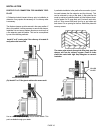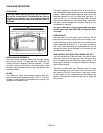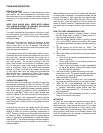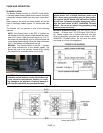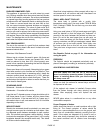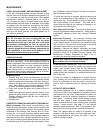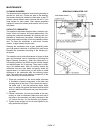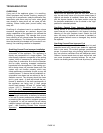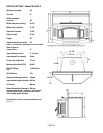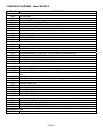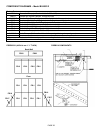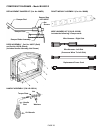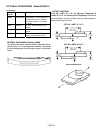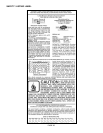TROUBLESHOOTING
PAGE 18
* SMOKES OUT FUEL DOOR WHEN OPEN
1. The primary air control is closed.
2. The chimney is too cool. Set the primary air con-
trol on "HIGH" with the bypass damper control
"OPEN" for a few minutes before opening the fuel
door.
3. Excess creosote will not only restrict your draft
but it will create a risk of a creosote fire. Strictly
adhere to maintenance requirements as outlined
in this manual. If excess creosote has built up on
the inside of the firebox sides and door, burn a
small hot fire at intervals that are more frequent
with air control on HIGH for a few minutes.
4. Deposits may have built up in the chimney and
are restricting the draft, or the spark arrester on
top of the chimney may be plugged.
5. Chimney diameter too large or too small to pro-
vide adequate draft.
6. The house is too airtight (usually takes 20 to 30
minutes for problem to appear as stove lowers air
pressure in house). Crack a window open or pro-
vide an outside source of air near stove.
7. Insufficient vertical height to chimney to achieve
adequate draft.
8. The combustor is plugged from engaging too
soon (remove combustor and clean, see Mainte-
nance section).
* DOES NOT PRODUCE ENOUGH HEAT
1. Using green or insufficiently cured wood.
2. Excessive draft.
3. High ceilings (heat rises quickly, but can be recir-
culated by a well-placed ceiling fan with a win-
ter/summer switch).
4. The area to heat, is too large (square foot heating
estimates are based on "average" climates and
home design.)
5. There's an obstruction in the chimney.
6. The chimney or chimney cap is restricted by
creosote preventing enough draw to sustain a
"HIGH" heat rate.
7. Combustor light off has not occurred.
* DOES NOT MAINTAIN A FIRE
1. Soft wood does not burn as long or as well as seasoned
hardwood resulting in a short burn time.
2. Wood size too small. Burns at too rapid a rate.
3. The gasket seal on the fuel door, ash dump cover or
glass is leaking air. Repair or replace it if necessary.
4. There is an obstruction in the chimney.
5. The stove was not up to normal operating temperature
before the bypass damper control was pushed closed.
6. Excessive draft.
* BACKPUFFING
1. Downdraft in the chimney (may need a special wind
cap).
2. The catalytic combustor is too hot (avoid burning
soft, pitchy woods, or large amounts of small-
diameter wood).
3 The house is too air tight (ventilation is needed).
4. Insufficient vertical height to chimney to achieve
adequate draft.
ODORS
1. Creosote accumulation in firebox (brush out on next
cleaning).
2. Chimney downdraft when stove is not operating
(close primary air control).
3. Catalytic combustor not functioning.
4. Paint curing on first several burns.
* DIRTY GLASS
1. Poor draft conditions.
2. Long burn periods at low draft settings.
3. Burning wet, pitchy or spongy wood.
4. Poorly arranged logs (too close to glass).
* Draft problems; If installing into a larger flue, it
may be necessary to use a full length liner to
achieve adequate draft for the appliance. A draft
gauge should read a minimum of .05" W.C.
(inches water column) not to exceed .07" W.C.
for optimum performance (see Draft Require-
ments).



